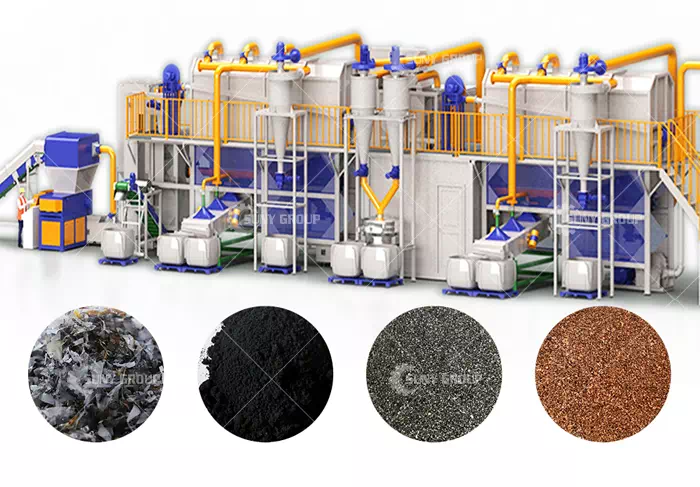With the popularity of electric vehicles and portable electronic devices, lithium-ion batteries, as representatives of high-performance batteries, play an important role in the field of energy storage. However, with the widespread application of lithium-ion batteries, the problem of battery waste disposal and recycling has become increasingly prominent. This article will discuss the process and related equipment of lithium-ion battery recycling, focusing on the key role of crushing, sorting and carbonization technology in lithium battery recycling.

Lithium-ion Battery Recycling Process Equipment
1. Crushing pretreatment:
The first step in lithium-ion battery recycling is to pre-shred the battery. This process usually uses specially designed crushing equipment such as hammer crushers or cutters. By crushing the battery, the electrolyte inside can be effectively released and the battery components can be separated.
2. Sorting and classification:
The broken battery residue needs to be further processed through sorting and classification. This process uses advanced sorting equipment such as vibrating screens, air flow separators, and magnetic separators. Based on different physical properties and chemical composition, these devices can effectively separate and recycle metals, plastics and other valuable components from battery residues.
3. Carbonization treatment:
In lithium-ion battery recycling, carbonization treatment is an important link. Carbonization is the process of converting organic matter into carbon-like substances in a low-oxygen or oxygen-free environment by heating battery residues. This process can be carried out using equipment such as rotary kilns, furnaces or carbonization furnaces. Carbonization helps convert battery residue into high-purity carbon materials that can be reused in battery production or other industrial applications.
1. Crusher:
Crusher is a commonly used crushing equipment suitable for preliminary crushing of lithium-ion batteries. It has a high-speed rotating hammer head that can break batteries into small pieces for subsequent processing, and can be customized and produced according to customer needs.
2. Vibrating screen:
The vibrating screen is a commonly used sorting equipment that separates metal and plastic from battery residues through a vibrating screen. Vibrating screens classify and separate particles of different sizes based on particle size and weight.
3. Air flow separator:
The airflow separator uses the power of airflow to separate light components from heavy components in battery residues. By adjusting the speed and direction of the air flow, the air separator effectively separates metals and plastics.
4. Carbonization furnace:
The carbonization furnace is a key piece of equipment used in lithium-ion battery recycling. It provides a low-oxygen or oxygen-free environment that converts organic matter in the battery residue into carbon-like material through heating. The temperature and processing time of the carbonization furnace can be adjusted according to different requirements.
1. High performance:
Crushing, sorting and carbonization equipment combines advanced technology and processes to efficiently process lithium-ion battery residues. They can quickly and accurately separate and recover valuable metals and other components, improving recycling rates and resource utilization.
2. Environmentally friendly and sustainable:
These devices focus on environmental protection when disposing of lithium-ion battery residues. The carbonization process can convert organic matter into stable carbon-like substances and reduce the emission of harmful substances. At the same time, through effective sorting and recycling, dependence on natural resources can be reduced and the impact on the environment can be reduced.
3. Versatility:
The crushing, sorting and carbonization equipment has good adaptability and can handle different types of lithium-ion batteries, including electric vehicle batteries, mobile electronic device batteries and energy storage system batteries. This gives these devices broad application prospects in different sizes and types of lithium battery recycling operations.
4. Economic benefits:
By using crushing, sorting and carbonization equipment, lithium-ion battery recycling companies can achieve improved economic benefits. High recycling rates and resource reuse reduce raw material procurement costs, while recycled metals and other components can be sold as high-value recycled materials, increasing revenue streams.
Lithium-ion battery recycling processes and equipment play a key role in solving battery waste disposal and resource recovery. Through crushing, sorting and carbonization technology, these devices enable efficient battery residue processing and recycling of valuable components. Their advantages include increased recycling rates, reduced environmental impact, adaptability to many types of lithium-ion batteries, and economic benefits. By continuing to promote the development and application of lithium-ion battery recycling technology, SUNY GROUP can help customers effectively solve battery waste disposal problems. If you have relevant questions or needs, please feel free to contact us for consultation.
Thank you for your interest in suny group. If you want to learn more about our E-waste recycling plant, copper wire recycling machine and other machines, Contact us now to find out what we can do for you next project!E-mail:sunymachine@gmail.com | Whatsapp:+8613674945231